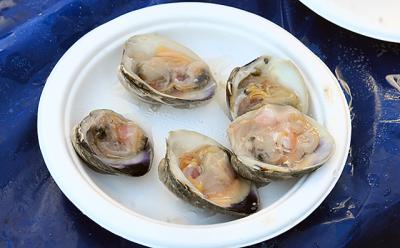Seasons by the Sea: How ’Bout Them Clams

Clams have already been covered in this column, but there’s always more to learn and more recipes to be shared. What better way than to spend the day immersed in clammy activities?
The first stop was in Amagansett, where the East Hampton Town Trustees’ Largest Clam Contest, postponed due to Hurricane Joaquin, was taking place on Sunday. Outside the American Legion Hall you could wait in line for clams on the half shell and buy raffle tickets for a chance to win the prettiest little Pooduck skiff built by the East End Classic Boat Society. Inside, you could check out the largest clam entries.
Good God, those Napeague Bay clams are on steroids! We admired the amateur clam chowder contest selections and got information from the East Hampton Town Shellfish Hatchery, including seeding maps from previous years, a helpful tool for those serious about clamming, scalloping, and oystering. F.Y.I., oysters take two to three years to reach harvest size, clams four to five, and scallops are harvestable during their second year. So do the math and get a seeding map according to your mollusk desires.
Best of all, for no charge whatsoever, you could dine on Fred Overton’s famous clam chowder, dark as dishwater, but briny and light. For hours, huge cauldrons of steaming chowder were wheeled out of the kitchen as Mr. Overton worked his magic behind closed doors.
What does one do after this Mercenaria mercenaria immersion? Why, go to Bostwick’s, of course, for more clams. In this case, bellies and strips. And who better to go with than Peter Bologna, a.k.a. Pebo, a fellow who knows his way around a clam rake and a kitchen. Peter clams all year round in Accabonac Harbor and always strikes gold. His favorite way to eat a clam is while he is clamming, in warmer waters, about 70 degrees. Have knife, will feast.
He shared his recipe for clams and pasta, all cooked together on the grill, but it was hard to pay attention when presented with platters of clams and oysters and shrimp and flounder and a bucket with four kinds of hot sauces.
A friend asked recently why “spaghetti alle vongole” is so perfect in Italy, no matter where you try this dish. Certainly one reason is the pasta. Whether dried or fresh, it will be superior when eaten at the source. And chances are, the garlic, lemons, olives for oil, and parsley incorporated into the dish were grown within miles of where you consume it. Lastly, their clams are different; they use the vongola (Venerupis decussata), Cozza (Mytilus galloprovincialis), and Tellina (Donax trunculus). The Italians prefer spaghetti to linguine and don’t believe in the addition of cheese.
Another friend asked why we don’t have clam shacks all up and down the East End, like they do in Ipswich, Mass. Well, they too, have a different variety of clam, Mya arenia, steamer, or Ipswich clams, which have long necks, soft hanging bellies (like me, after lunch at Bostwick’s), and fragile shells that don’t close completely.
What gives clams (and other bivalve mollusks) their distinctive flavor? For these complicated questions we must always turn to Harold McGee’s “On Food and Cooking: The Science and Lore of the Kitchen.” Oysters, clams, and mussels achieve their savoriness by accumulating “internal taste-active substances as an energy reserve and to balance the external salinity of their home waters.” They store energy not as fat, but as amino acids. The saltier the water, the more savory the shellfish. And why are we still told to only consume shellfish during months with an “R,” in other words, the colder months of the year? Without getting into too much sexy detail, let’s just say that when the waters are warmer and the lights are turned down and the Barry White music is turned up, your clams et al are getting busy, ready to spawn. There is also the possibility of more red tide algae in warmer waters, but that’s not as much fun to talk about. . . .
Long ago, clamshells were used as wampum for trading. Some sites claim that the purple interior of clamshells was especially prized and considered more valuable, but according to the Mohican Press, the white and purple shells also served different purposes. If someone arrived wearing a white clamshell belt, they were bringing good news. If they wore a purple shell belt, they came with news of disaster. Like more white men coming to “buy” land, perhaps?
Indeed, as Mr. McGee says, “the secret to the mollusk’s success — and their strangeness — is their adaptable body plan.”
I love clams in all their forms, except for maybe the geoduck (pronounced gooey duck), which I have tried in a few Asian restaurants and came face to face with (face to siphon?) in Seattle. Just give me some local littlenecks, lots of parsley and garlic, some good, dry white wine, and I think the resulting dish would rival any that one could find in Italia. Here are some recipes to inspire you.
Click for recipes.
